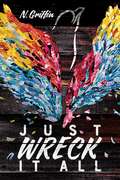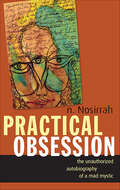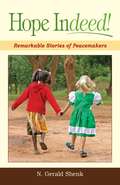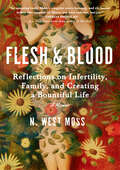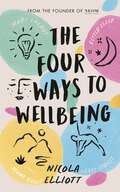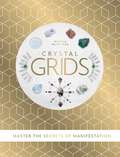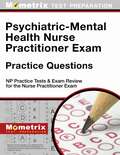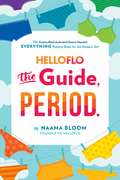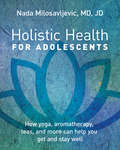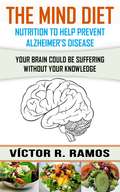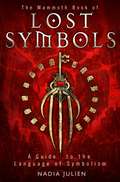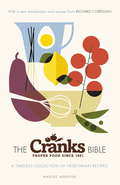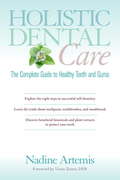- Table View
- List View
Just Wreck It All
by N. GriffinCrippled with guilt after causing a horrific accident two years earlier, sixteen-year-old Bett’s life is a series of pluses and minuses. But when the pluses become too much to outweigh the minuses, Bett is forced to confront her self-harming behavior in this stirring and powerful novel about self-forgiveness.Bett’s life is a series of pluses and minuses: good moments she believes she doesn’t deserve, and self-punishments that she believes she does. <P><P>Two years ago Bett was athletic, fearless, and prone to daredevil behavior (fizzicle feats, she called them). But when a dare gone wrong leaves her best friend severely and permanently injured, everything changes. Now, Bett is extremely overweight, depressed, and forbids herself from enjoying anything in life, from her favorite sports to having friends—anything she determines to be a plus. But some pluses can’t be avoided, and when that happens, Bett punishes herself through binge eating. As long as she can keep the pluses and minuses balanced, she can make it through another day. Then, on the first day of junior year, it’s immediately clear that Bett has to shift gears. The driver of the small motley crew on the bus with her is also the school’s track coach who is hell-bent on recruiting them all for his team. And running happens to be Bett’s favorite thing to do, which means it’s the last thing she’ll allow herself to do, or else she’ll have to minus each run out with a dozen Hostess cupcakes. Not only that, but there’s a vandal destroying all the art at the school, and Bett finds herself and her new teammates at the forefront of the rebellion against the vandal—despite the fact that this rebellion involves the very same fizzicle feats Bett swore she’d NEVER do again. <P><P>Suddenly Bett’s life is full of pluses, too many to balance with even a grocery store’s worth of cupcakes. And she finds herself agonizing: Should she continue to punish herself for enjoying life when her best friend can’t in the same way? Or should she finally allow herself to live again?
Practical Obsession: The Unauthorized Autobiography of a Mad Mystic
by N. NosirrahIn this remarkable spiritual memoir, written by one of the most astonishing and enigmatic mystics of the modern era, Nosirrah takes us through the arc of his life from his birth, which he claims never actually happened, to his own death, amazingly described by Nosirrah himself in great detail. He recounts the rollicking events that occurred as this spiritual genius encountered the unfolding of his life and his message for humankind. Scholars will no doubt study this tome to help explain the brilliant writings of a man who so transcended his own existence that he was unable to authorize his own autobiography.
ICU: Ullae Nadappathu Enna
by N. RamakrishnanWhen a patient is admitted into ICU in a hospital in a critical condition, it is a normal scene outside the Unit that the kith and kin waiting with anxiety, not knowing what happens inside. If someone unfolds the inside of the Unit how good it would be. This book does it! Apart, you can also get some tips on reducing weight, cholesterol control, and diabetes control.
Aaan-Penn
by N. ShaliniThis book unfolds many myths and answers many puzzles on the subject of sex such as marriageable age, infertility, childbirth, HIV etc., and their related social and psychological aspects in a lucid simple and emphatic language.
Teen-Age Prachnaigal
by N. ShaliniThis book explains the transition period of adolescence and what teenagers should be aware when they sexually attain an important stage in their life.
Hope Indeed: Remarkable Stories Of Peacemakers
by N. ShenkGerald Shenk has traveled to and lived in many difficult places. He goes to teach-and to spot people who act out of hope. When he began to feel fortified by what he discovered, even foolishly rich, he wrote what he had witnessed and heard for the rest of us. Hope Indeed! is his collection of stories of stunningly ordinary people behaving with extraordinary hope. Here are the stories of- Ned Wyse, a farmer/pastor in Michigan, chosen randomly for a violent beating by some neighborhood kids, and what he did about it. The Palestinian parents who gave their young murdered son's organs to ill Jewish children. The Amish, who subverted the vicious violation of their innocent children in the Nickel Mines school by refusing to multiply the horror, and instead offered forgiveness and generosity. Jewish Cantor Michael Weisser and his family who took carry-out food to the white supremacists who had harassed them mercilessly. The German Lutheran pastor couple who offered their home to recently desposed and homeless Erich Honecker, who had ruthlessly ruled East Germany. Brother Ivo who kept bringing former Catholic and Muslim neighbors together as war escalated in Bosnia. Says Shenk, "Here are stories to rehearse if we want to become people who subvert vengeance with kindness."
Flesh & Blood: Reflections on Infertility, Family, and Creating a Bountiful Life: A Memoir
by N. West MossHonest, warm, and witty, this memoir reads like a chat with a dear friend sharing her insight and her vulnerabilities and taking us along as she heals. Complete with family stories over cocktails and a new friend named Claude, who happens to be a praying mantis. &“I drive and say to myself, if I am dying, if this is how I die, then this is how I die.&” When N. West Moss finds herself bleeding uncontrollably in the middle of a writing class, she drives herself to the hospital. Doctors are baffled, but eventually a diagnosis—hemangioma—is determined and a hysterectomy is scheduled. We follow Moss through her surgery, complications, and recovery as her thoughts turn to her previous struggles with infertility, to grief and healing, to what it means to leave a legacy. Moss&’s wise, droll voice and limitless curiosity lift this beautiful memoir beyond any narrow focus. Among her interests: yellow fever, good cocktails, the history of New Orleans, and, always, the natural world, including the praying mantis in her sunroom whom she names Claude. And we learn about the inspiring women in Moss&’s family—her mother, her grandmother, and her great-grandmother—as she sorts out her feeling that this line will end with her. But Moss discovers that there are other ways besides having children to make a mark, and that grief is not a stopping place but a companion that travels along with us through everything, even happiness. With public figures like Chrissy Teigen and Meghan, Duchess of Sussex, speaking out about infertility recently, women are eager for voices that acknowledge their struggles. Fans of Lena Dunham, Leslie Jamison, and Jenny Lawson—along with readers of medical memoirs like When Breath Becomes Air and The Bright Hour—will find that connection in Moss&’s Flesh & Blood.
The Four Ways to Wellbeing: Better Sleep. Less Stress. More Energy. Mood Boost.
by Nicola Elliott NEOMThe stunning book from wellbeing experts NEOM and discover the secrets to BETTER SLEEP. LESS STRESS. MORE ENERGY. MOOD BOOST.‘A bible of knowledge with lots of great advice’ Alesha Dixon‘An invaluable guide to holistic wellbeing’ Joshua Fletcher (@anxietyjosh) anxiety therapist and author************These are the four pillars of wellbeing and there is no one better placed to show you how to achieve each of them than Nicola Elliott, founder of NEOM.After eighteen years of building the UK's leading wellbeing business, Nicola has been there, done that and got the weighted blanket. In this beautifully illustrated guide, she combines her own no-nonsense advice with insights from experts on sleep, stress, energy and mood, so that you can find the solutions that work for you.Wellbeing starts with the little moments so whether you've got 30 seconds or 30 minutes, you will find simple tips and tricks that will suit your lifestyle and help you feel better than ever, the NEOM way.
Crystal Grids
by NICOLA MCINTOSHMARILYN WHALL is a Medium, Spiritual Teacher and Mentor from Sydney, Australia. Loneliness, abuse and despair were the only aspects of life Marilyn knew until one day she heard a voice deep within telling her to listen to her heart. By following this voice she began a journey which not only changed her life but the thousands of people who have been touched by her words. Once a shy and demure child, Marilyn has become a brilliant light for the spirit world. In this book you will learn how Marilyn blossomed through love and compassion as the unseen world revealed to her that love is the key to heal pain and move mountains. Marilyn shares in Knowing some of the many steps that have guided her to a place of eternal gratitude and peace.
Plant Spirit Medicine: A Guide to Making Healing Products from Nature
by NICOLA MCINTOSHPlant spirit medicine: what is it? Our modern world is travelling at such a speed, we have become separated from the natural world, which should be sustaining us physically, emotionally and spiritually. This book is about reconnecting with nature and the plants in our environment; it's also about learning to listen to the plants and applying what they have to tell us to mend that disconnection. Indigenous peoples from all around the world have worked with plant spirits for thousands of years, and this is how they came to know what specific plants were used for. In this book, you will learn how to listen to the plant spirits and how to access the medicine available through plants. You will also learn about plant spirit medicine making, from drying herbs to extracting plant properties to infusing oils, as well as how to make ointments, lotions, creams, smudge sticks and many more herbal products. Plant Spirit Medicine Making can help heal the parts of our soul and psyche that so desperately need it at this time in the story of humanity.
Psychiatric-Mental Health Nurse Practitioner Exam Practice Questions: NP Practice Tests and Exam Review for the Nurse Practitioner Exam
by NP Exam Secrets Test PrepMometrix Test Preparation's Psychiatric-Mental Health Nurse Practitioner Exam Practice Questions are the simplest way to prepare for your Nurse Practitioner Exam. Practice is an important part of preparing for a test and improving your chance of success. <p><p> Mometrix practice questions are designed to prepare you for the real test. You could know everything that is going to be covered on the test but still perform poorly if you have never worked with NP practice questions. Being familiar with the different types of questions and answer choices that you might see on the official test is a big advantage. <p><p> Another benefit of taking practice tests is that you can measure your performance. They help you decide if you need to study and practice more or if you're ready for test day. Doing well on a Mometrix practice test helps you gain confidence that you are prepared. If you struggle, the practice test helps identify areas where you need to work. Using our NP practice test questions allows you to reinforce your strengths and improve your weaknesses. <p><p> Mometrix includes detailed answer explanations for each question. It may sound obvious, but you need to know which questions you missed and why you missed them. This helps you avoid making the same mistakes on the real test. That is why our Psychiatric-Mental Health Nurse Practitioner Exam Practice Questions include answer keys with detailed answer explanations. These in-depth answer explanations will help you to better understand any questions that were difficult for you. <p><p> Mometrix Test Preparation is not affiliated with or endorsed by any official testing organization. All organizational and test names are trademarks of their respective owners.
HelloFlo: The Everything Puberty Book for the Modern Girl
by Naama BloomFrom the founder of HelloFlo, a modern and insightful guide to periods and puberty for a new generation When will I get boobs? Does wearing a tampon hurt? What's the deal with menstrual cups? Seriously, when will I get boobs? Honest, funny, and unafraid of the messy, real-life facts about a girl's changing body, this is definitely not your mother’s puberty book. HelloFlo founder Naama Bloom’s mission is to create informed, empowered young women who are unafraid to ask questions and make the best choices for themselves and their bodies. A celebration of women's bodies and all the confusing, uncomfortable, silly, transformative, and powerful changes that occur during puberty.
Holistic Health for Adolescents
by Nada MilosavljevicHow yoga, aromatherapy, teas, and more can help you get and stay well. Stress. Fatigue. Depression. Sleeping problems. Issues with focus and concentration. Headaches. Substance abuse. These are all common problems that teenagers deal with. We have long been acquainted with the conventional treatments of therapy and prescription medications. It turns out there are also many complementary and alternative therapies available that have evidence-based track records of success. This book presents therapies based around the five senses—including acupressure, aromatherapy, yoga, sound/music therapy—to help teens with their mental health. Each chapter reviews the signs and symptoms of a problem and presents detailed treatment protocols and therapies. This all-inclusive book is one-stop shopping for teens and parents looking for new, synergistic, and different ways to handle life’s problems. As both a trained medical doctor on the faculty at Harvard Medical School and a noted complementary and alternative medicine specialist, Nada Milosavljevic brings a rich background of experience to this book.
The Mind Diet, Nutrition to Help Prevent Alzheimer's Disease
by Nadia Hleb Victor R. RamosYour brain could be suffering without your knowledge. Most likely your brain is suffering at this very moment and you have no way of knowing or finding out, until you start to notice irreversible signs of decline. Our current diet is leading to all kinds of health problems: obesity, cancer, diabetes and cardiovascular disease, with increasing evidence that it also triggers Alzheimer’s disease, now seen by some researchers as another form of diabetes, an issue addressed in this book. What can we do? Awareness campaigns for healthy diets have achieved limited success. Many continue to follow fad diets, but most do it for aesthetic reasons or health problems. Some popular diets like the Mediterranean and DASH diets are specifically focused on preventing cardiovascular disease and hypertension. And what about the brain? We have left it to the mercy of our bad eating habits, preservatives in processed foods, excess sugar and fat, and environmental contaminants. All this happens because our brain does not complain – it does not have pain receptors – so we are not aware of its suffering and deterioration until it is too late. It is time to take care of our brain and prevent it from failing before the rest of our body by following a healthy diet that maintains its health and proper functioning. In "The MIND Diet, Nutrition to Help Prevent Alzheimer's Disease,” you will discover what Alzheimer’s is and its causes and symptoms, among other topics, including a nutritional strategy for your daily life – all with a simple and direct style, addressed to the general public. As an easy-to-follow diet based on the latest scientific studies, the MIND diet can improve your overall health and dramatically reduce your risk of getting Alzheimer's disease.
The Mammoth Book of Lost Symbols: A Dictionary Of The Hidden Language Of Symbolism (Mammoth Books)
by Nadia JulienHumanity has always used symbols-material objects used to denote difficult, abstract concepts-to describe thoughts and feelings, or to protect secret truths from common knowledge. This concise A-Z guide is a fascinating work of reference that brings to light all the symbols and symbolisms of the world, many aspects of which have been lost to time, including Freemasonry, the Kabbalah, the tarot, astrology, alchemy, Zoroastrianism, and ancient cultures from Egypt to Japan.
The Mammoth Book of Lost Symbols: A Dictionary of the Hidden Language of Symbolism (Mammoth Books #343)
by Nadia JulienHumanity has always used symbols-material objects used to denote difficult, abstract concepts-to describe thoughts and feelings, or to protect secret truths from common knowledge. This concise A-Z guide is a fascinating work of reference that brings to light all the symbols and symbolisms of the world, many aspects of which have been lost to time, including Freemasonry, the Kabbalah, the tarot, astrology, alchemy, Zoroastrianism, and ancient cultures from Egypt to Japan.
Greedy Girl's Diet
by Nadia SawalhaNadia Sawalha has always loved cooking, but until recently rarely ate her own food. Like a lot of women, whilst her family tucked in to delicious dishes, she nibbled on diet food. Later, ravenously hungry, she binged, somehow convincing herself that the calories didn't count if nobody saw her eating them. Two years ago, after decades of fluctuating weight, she decided enough was enough: * She wasn't going to start a new diet tomorrow. * She wasn't going to start a new diet ever again. * She was going to eat normal meals with her family and, most importantly, she was going to do so for the rest of her life. Since then, Nadia has lost and kept off 31/2 stone, by simply throwing away the diet books. Instead she shaved off the hidden calories, all without anyone noticing. A little less oil here, a different cut of meat there; brown rice instead of white, more herbs, spices and colour; and a dessert every day! The result is The Greedy Girl's Diet, which is packed with more than 100 delicious recipes, and Nadia's invaluable tips and advice on how to achieve a slim, fit and healthy body.
Greedy Girl's Diet
by Nadia SawalhaNadia Sawalha has always loved cooking, but until recently rarely ate her own food. Like a lot of women, whilst her family tucked in to delicious dishes, she nibbled on diet food. Later, ravenously hungry, she binged, somehow convincing herself that the calories didn't count if nobody saw her eating them. Two years ago, after decades of fluctuating weight, she decided enough was enough: * She wasn't going to start a new diet tomorrow. * She wasn't going to start a new diet ever again. * She was going to eat normal meals with her family and, most importantly, she was going to do so for the rest of her life. Since then, Nadia has lost and kept off 31/2 stone, by simply throwing away the diet books. Instead she shaved off the hidden calories, all without anyone noticing. A little less oil here, a different cut of meat there; brown rice instead of white, more herbs, spices and colour; and a dessert every day! The result is The Greedy Girl's Diet, which is packed with more than 100 delicious recipes, and Nadia's invaluable tips and advice on how to achieve a slim, fit and healthy body.
Greedy Girl's Diet Second Helpings!
by Nadia SawalhaWe've all been there: you start a diet with the best of intentions, but, after a busy day at work or a nightmare journey home, the thought of spending an age chopping vegetables for a salad or gloomily sipping a flavourless soup is just too much. Before you know it, you're reaching for the frozen pizza or dialling the number of your favourite takeaway. That's where Nadia comes in. In Greedy Girl's Diet, she proved that healthy food doesn't have to be dull and that you can still have treats without overindulging. Now she's back, with a host of family-friendly, healthy and nutritious recipes (including her famous desserts!) that can be prepared and on the table in no time. Greedy Girl's Diet: Second Helpings is full of delicious, diet-friendly dishes, with one chapter specialising in ten-minute meals, another for half-hour dinners - perfect for a weeknight - and a whole host of lunchbox suggestions. There's a section on guilt-free 'junk' food, a guide to making takeaway-style dishes without the calories, and even an emergency three-day detox for when you just have to fit into that dress.
Greedy Girl's Diet Second Helpings!
by Nadia SawalhaWe've all been there: you start a diet with the best of intentions, but, after a busy day at work or a nightmare journey home, the thought of spending an age chopping vegetables for a salad or gloomily sipping a flavourless soup is just too much. Before you know it, you're reaching for the frozen pizza or dialling the number of your favourite takeaway. That's where Nadia comes in. In Greedy Girl's Diet, she proved that healthy food doesn't have to be dull and that you can still have treats without overindulging. Now she's back, with a host of family-friendly, healthy and nutritious recipes (including her famous desserts!) that can be prepared and on the table in no time. Greedy Girl's Diet: Second Helpings is full of delicious, diet-friendly dishes, with one chapter specialising in ten-minute meals, another for half-hour dinners - perfect for a weeknight - and a whole host of lunchbox suggestions. There's a section on guilt-free 'junk' food, a guide to making takeaway-style dishes without the calories, and even an emergency three-day detox for when you just have to fit into that dress.
Nadia Sawalha's Little Black Dress Diet
by Nadia SawalhaNadia's Little Black Dress Diet, covering 100 recipes from Breakfast through to Dinner - not forgetting those scrumptious puddings - shows you how to make healthy yet succulent dishes to help you slip into your little black number. From quick and tasty recipes for thinner dinners and sinless snacks, Nadia gives her top tips on how to lose the weight - tricks to 'beat the bloat' and survival tips for the party season. And once you're there, Nadia reveals how to look your finest on the day, from which shoes to wear to the correct posture to adopt, everything you need to complement the new you. This is an essential book for anyone wishing to look and feel fabulous in their LBD.
Nadia Sawalha's Little Black Dress Diet
by Nadia SawalhaNadia's Little Black Dress Diet, covering 100 recipes from Breakfast through to Dinner - not forgetting those scrumptious puddings - shows you how to make healthy yet succulent dishes to help you slip into your little black number. From quick and tasty recipes for thinner dinners and sinless snacks, Nadia gives her top tips on how to lose the weight - tricks to 'beat the bloat' and survival tips for the party season. And once you're there, Nadia reveals how to look your finest on the day, from which shoes to wear to the correct posture to adopt, everything you need to complement the new you. This is an essential book for anyone wishing to look and feel fabulous in their LBD.
The Cranks Bible: A Timeless Collection of Vegetarian Recipes
by Nadine AbensurA classic collection of healthy and delicious plant-based recipes from the Cranks kitchenSince opening their first restaurant in 1961, Cranks have been pioneers of vegetarian cuisine and champions of organic produce. Here, celebrated writer and chef Nadine Abensur presents over 200 classic meat-free recipes from the Cranks kitchen. From pumpkin and parsley risotto to aubergines with smoked ricotta, passion fruit ice-cream, walnut and raisin loaves and plum jam, every recipe is packed full of beautifully simple, natural ingredients that will nourish both body and soul. With advice on selecting the freshest seasonal produce, eating healthily and enjoying the experience of making mouth-watering food, THE CRANKS BIBLE is a celebration of vegetarian cooking and an essential resource for every home.
The Cranks Bible: A Timeless Collection of Vegetarian Recipes
by Nadine AbensurA classic collection of healthy and delicious plant-based recipes from the Cranks kitchenSince opening their first restaurant in 1961, Cranks have been pioneers of vegetarian cuisine and champions of organic produce. Here, celebrated writer and chef Nadine Abensur presents over 200 classic meat-free recipes from the Cranks kitchen. From pumpkin and parsley risotto to aubergines with smoked ricotta, passion fruit ice-cream, walnut and raisin loaves and plum jam, every recipe is packed full of beautifully simple, natural ingredients that will nourish both body and soul. With advice on selecting the freshest seasonal produce, eating healthily and enjoying the experience of making mouth-watering food, THE CRANKS BIBLE is a celebration of vegetarian cooking and an essential resource for every home.
Holistic Dental Care: The Complete Guide to Healthy Teeth and Gums
by Nadine Artemis Victor ZeinesA comprehensive guide to natural, do-it-yourself oral care, Holistic Dental Care introduces simple, at-home dental procedures that anyone can do. Highlighted with fifty-three full-color photos and illustrations, this book offers dental self-care strategies and practices that get to the core of the problems in our mouths--preventing issues from taking root and gently restoring dental health. Based on a "whole body approach" to oral care, Holistic Dental Care addresses the limits of the traditional approach that treats only the symptoms and not the source of body imbalances. Taking readers on a tour of the ecology of the mouth, dental health expert and author Nadine Artemis describes the physiology of the teeth and the sources of bacteria and decay. Revealing the truth about the artificial chemicals in many toothpastes and mouthwashes, Artemis also discusses the harmful effects of mercury fillings and the much safer ceramic filling options that are available. Covering topics that include healthy nutrition, oral care for children, and the benefits of botanical substances and plant extracts for maintaining oral health, Artemis introduces a comprehensive eight-step self-dentistry protocol that offers an effective way to prevent decay, illness, acidic saliva, plaque build-up, gum bleeding, inflammation, and more.
